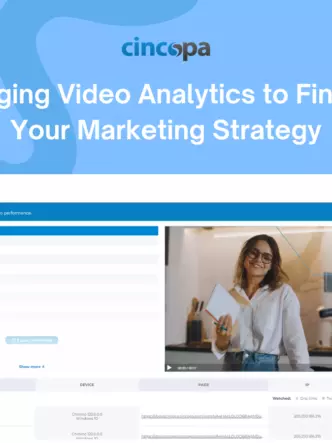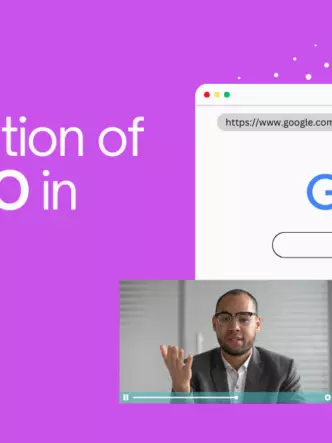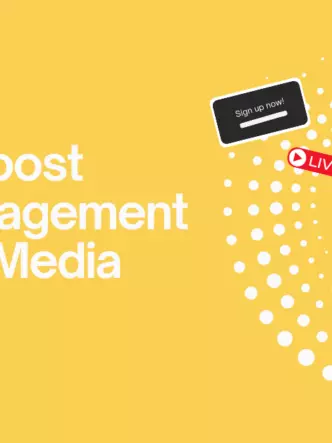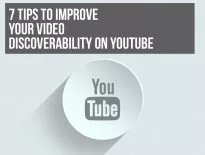Cisco Visual Networking Index (VNI) Complete Forecast states that there will be nearly 1.9 billion Internet video users by 2021 compared to 1.4 billion in 2016. Internet users across the globe will be watching 3 trillion minutes of video per month by 2021.
With such a heavy increase in video traffic, the role of video analytics is more important than ever.
Most video marketing platforms provide analytics, but the question is how to harness their power to inform your marketing decisions. Analytics enable you to create video campaigns supported and lead by data.
You cannot optimize what you don’t measure. Analytics provide resourceful insights on key performance metrics over a period of time to help you make the right decisions.
What is video marketing analytics?
As with any form of marketing, when doing video marketing, it’s important to be able to measure and analyze your results. By using video marketing analytics, you can:
- Get insight into who is viewing your videos.
- Help you to find out how popular your content is with your audience.
- Create videos that increase engagement.
- Figure out what campaigns are working.
- Determine and spend your video marketing budget effectively.
Many businesses are failing to use more than the most elementary analytics to measure the performance of their videos. They never go beyond the views, likes and comments their videos receive. This means they are investing in video without truly understanding if it’s giving them the results they’re looking for.
The use of video analytics helps you to fine-tune your message, sharpen the focus of your videos and make sure you’re reaching the right audience. 30% of marketers have said that with the use of videos, the number of support calls they receive dropped considerably.
Why is video marketing analytics critical?
You should always start a video campaign with objectives and understand what you’re hoping to achieve. From there you can tie specific metrics to your goals to measure success. The more planning you do, the easier reporting on metrics becomes.
If you want to know whether your video marketing campaigns are effective, you need to ask yourself some important questions:
Is your video campaign targeting the right audience? You need to see demographic data to find out.
Is any of your core audience not responding to your campaign? If you’re trying to target a demographic of males aged 20-30 and they are not watching your videos, you need to figure out why.
Are viewers abandoning your videos? This can happen easily – a viewer may just have clicked a wrong link. However, if you’re seeing abandonment in large numbers, you might need to go back to the drawing board.
Are you giving viewers a solid call-to-action? If your audience is not converting, it could be because people are not certain about what action to take next.
Are viewers continuing to engage with your brand? Some viewers will watch one video and move on, but others will continue to engage. You need to foster this engagement and create a relationship with these viewers. If viewers click out and don’t come back, you can try to retarget them and encourage them to interact.
The only way to answer these questions is by using video analytics. You need to depend on observations based on analytics to revise your marketing strategies and create new ones.
Whether a video is a short interview, a product demo or an animated explainer video, you need to properly analyze its impact in terms of audience retention and usefulness.
Improvements are then based on the insights the analytics offer. You can then use A/B testing and monitor key performance indicators to find out whether the changes you make are successful.
Sources of video analytics
Video marketing analytics can come from many different sources. If you use a third-party video hosting site, you will receive data to help you understand how your videos are performing.
The most popular video hosting sites, like YouTube, offer analytics to help you understand and evaluate the performance of your videos. Social media platforms, like Facebook, also offer analytics. Google has its own analytic tools and using a paid video hosting platform will give you access to some excellent analytics.
Google Analytics
This tool connects all the sites you use for video marketing in one place. Beyond in-platform analytics, you can also use Google Analytics to see the impact your videos have on your overall digital marketing strategy.
For example, you can integrate your video platform to work with google analytics. By doing this you will be able to see how many visitors you’ve attracted your site through your videos, as well as how many of them are new visitors, how long they spend on your site, and whether they converted.
Video hosting platform analytics
Paid video hosting services offer excellent video analytics, precise performance metrics, and high SEO (search engine optimization) benefits. They facilitate channel-specific video content and help you publish it on various social media platforms from one location.
Cincopa for example, offers an advanced analytics suite. It provides demographic information and directly tracks viewer engagement. You can get data such as how long visitors watched and what actions they took when they finished watching.
Key video analytics metrics
Terms you should understand are:
- Impressions (the number of times a video has loaded in a user’s app or browser). This can be useful when compared with the number of views.
- Views (the number of times people click on a video – different platforms have different viewing durations that count as views). To get a view on YouTube, viewers must watch for at least 30 seconds.
- Play rates (divide impressions by views). For example, a video with 5,000 impressions and 500 views, would have a play rate of 10%.
- View length (the amount of time a viewer watched).
- Engagement rate (the number of people still watching at point x divided by the viewers who started watching).
- Preferred device types and operating systems.
- Viewer location (where viewer watched from).
- Source of view (platform video was seen on).
- Conversion rate (viewers who take action).
Views
The simplest metric when it comes to videos is how many users view it. The higher this number, the more people found your video worth watching. It’s easy to access this information on a video sharing platform such as YouTube where you can click on the analytics button below any of your videos.
What’s the benefit to your business of knowing the number of views?
- A video on a particular topic that generates more views than usual indicates its popularity with your audience. You can create more videos about similar topics that could have the same appeal. New viewers are more likely to watch your videos if you have a high number of views.
- If a video doesn’t attract many views, it could be for various reasons. It may not be because your audience isn’t interested in the topic but because you’ve posted it on a different platform to one they’re using. Find out which platform your core demographic is using and post it there.
- Views could be low because the information in the video doesn’t reflect the title. If you upload a video without keywords or tags or use longer titles, it may affect discoverability of a video and reduce views. Change your title and add relevant keywords and tags.
Play rate
When you divide your impressions by your views, it gives you your play rate. Your play rate shows you how effective your video is at enticing people to click on the play button.
What’s the benefit to your business of knowing the play rate?
You can try to increase the play rate by doing the following:
- Move the position of the video on the page or increase the size of the embed.
- Work on your thumbnail – pick one that’s more eye-catching, vibrant and relevant.
- Move your video to a different page to see if it performs better.
Audience Engagement
When you look at view numbers, you will only know how many people began watching your video. What’s equally important is to find out how long they watched. There’s no point in having exceptional view counts if viewers don’t watch long enough to take in information that could encourage them to take action.
Viewers tend to have short attention spans, and it may be difficult to hold their attention for long unless they are interested in the content.
If you want to find engagement rate, you need to separate your video into segments and then for each segment you divide the number of people still watching at a certain point by the number who started watching. If you have 100 segments, 1000 people started watching, and 700 are still watching after a minute, your engagement for that segment is 70%.
Are viewers only watching a couple of seconds of your video? Do they fast forward over certain parts? Do they watch certain parts over and over? The analytics are vital to improving your strategies. It gives you a good idea of what viewers are really looking for.
What’s the benefit to your business of knowing how long viewers watch?
- If you’re losing viewers right at the beginning of your video, work on making it engaging right from the start.
- If viewers are skipping over certain parts and watching others more than once, you have a great indication of what they find useful. You may be able to place more emphasis on what’s useful and cut out what’s not.
- Make sure the copy surrounding the video accurately reflects its content. If viewers expect an explanation of how to use your product and instead you give them an advert about why they should buy it, they’ll probably stop watching.
- If you can see that many viewers drop off at the same point, it’s a strong indication that your video could be too long. If you have anything unnecessary in your video, cut it out. Many users won’t spend more than a minute or two watching a video unless it’s highly informative.
The social media platform you post on will also determine the length of your video. Acceptable lengths are one minute for Facebook, 45 seconds for Twitter, 30 seconds for Instagram and two minutes for YouTube.
Using engagement graphs show you if viewers stop watching at a certain point. YouTube has an Audience Retention graph that pinpoints when people stop watching. If viewers are all dropping off at the same point, you need to work out why and change your video.
Are your videos too salesy? Are you going off on a tangent? Once you have a hypothesis as to why people are dropping off, you can continuously edit and test your videos to try and minimize drop-off rates.
Demographics
Analytics can also give you insight into who is watching your videos. You probably have a target audience in mind when targeting consumers with video content, but you won’t know if your assumptions are correct without checking video marketing analytics. Demographic information shows you which audiences are most interested in your videos.
What’s the benefit to your business of knowing who’s watching?
- If you’re not quite sure of your target audience, audience demographics could help to point you in the right direction.
- If your videos don’t seem to appeal to the right demographic, you may need to try different types of videos and distribute them in different ways.
- Demographic data could also help you to tap into new markets. Perhaps your videos are well received by a demographic you had not thought of targeting. You may see more conversions and sales by adjusting your marketing strategies. Targeting this demographic could be an opportunity you would not have even considered without monitoring analytics.
- Perhaps a particular segment of your audience is interested in a specific type of video – you could use the information to target that audience segment with the type of content they want to watch.
Viewer location
If your business only serves specific areas, you need to be sure you’re reaching customers in the areas you actually serve. There’s no point in reaching viewers in Australia if you’re a local plumber in Boston, America.
What’s the benefit to your business of knowing where viewers are located?
- If you’re largely based in a specific location, you need to use targeted, localized video campaigns to reach your audience.
- You may need to use Google paid ads or paid video hosting to promote videos in a particular region.
Traffic sources
Finding out how viewers found your video can improve your efforts at promotion. You will know which platforms generate views most effectively. Are viewers being referred from your social media channels? Are they coming from social media profiles of people who have shared your video? Are they finding it from watching similar videos on third-party hosting sites? Are they coming directly to your website from organic search results?
What’s the benefit to your business of knowing how viewers find your content?
You may think that as long as people are watching your video, it doesn’t matter where they’re coming from but knowing how viewers find your content helps you to know whether your distribution methods are working or not. Are your videos being watched on Facebook and not on Twitter? Have paid advertisements contributed?
- Using data like this, you can test different traffic sources and make adjustments to improve your results.
- If viewers are coming from your video being shared on Facebook, you can push this in your promotional strategies. You’re wasting time and money if you’re spending your marketing budget on the wrong social media platform.
- If your videos are being watched mostly on YouTube, and not driving people to your website, you may need to consider using a video hosting platform where your videos contribute to your website SEO.
Devices viewers use
Analytics reveal what devices your viewers are using to watch your videos. How someone watches your video can reveal a lot about their habits and help you to optimize your video content for specific devices.
What’s the benefit to your business of knowing what devices viewers are using?
- You can find out what the typical screen size and resolution is for viewers, so your videos display effectively.
- Are viewers watching from mobile devices? If so, you should optimize your content for on-the-go viewing, such as creating bite-sized videos that load fast. Some actions are more difficult when using a mobile phone, and you need to create suitable CTAs.
Interaction and feedback
A Nielsen survey of more than 30,000 people found that 66% viewers find that the ads in video-on-demand content are for products they don’t plan to purchase.
When someone watches your video all the way to the end, you’re on to a good thing. Interaction with your video is even better, particularly if you’re hosting on a third-party site.
Are links in the description leading them back to your site? The more traffic that comes to your website, the higher it ranks in search engines.
Are your viewers giving you a Like on Facebook or a Thumbs Up on YouTube? Are they commenting on your video or sharing it on social media? These actions all give your video more exposure.
Analytics will tell you not just how many times your video has been watched, but who have viewed it more than once.
What’s the benefit to your business of knowing how audiences responded to your video?
- A viewer who watches a video over and over is a highly qualified lead with whom you can begin developing a relationship.
- If your video shows low interaction rates, you may need to add more calls-to-action or tweak the wording so compel viewers to follow through.
- Try to judge the tone of comments and overall reaction to your video but remember that human emotions are complex. Feedback is qualitative in nature, but the important thing is not to forget the more human side to data and don’t be afraid to use it to create more emotive video content.
Conversions
No matter how entertaining a video may be, the content has a purpose. All of your marketing efforts are built around your business goals. Every video should have a call-to-action that audiences can respond to when viewing video content. To track the effectiveness of that call-to-action, you need to know the number of conversions.
Marketers must know the return on investment (ROI) of a video to justify the expense. The click-through rate tells you how many viewers of your video clicked on your call-to-action. The higher this percentage, the more your viewers are taking action, whether this is filling in a contact form, watching more content, signing up for a free trial or making a purchase.
What’s the benefit to your business of knowing the click-through rate?
A call-to-action alone is not enough. For example, if viewers watch a product demo but don’t click on a call-to-action that drives them to a landing page on your website, it could be because it is too generic. A more relevant CTA could increase conversions. How can you improve your CTAs?
- Try placing it at a different point in your video. Placing a CTA at the beginning of a video works better than placing in mid-roll or post-roll.
- Make your CTA more visually appealing. It must match the video you place it in, fitting its tone and look.
- Make it highly relevant to your video content.
Further considerations
As a marketer, you must pay attention to the data, but you shouldn’t jump to conclusions. Every business is different, and you need to look at the analytics in the light of your business to use them effectively.
Limitations when using YouTube to host your videos
Uploading video to third-party sites, like YouTube, is free and people are accustomed to going to YouTube for video content. The site is perfect for getting videos in front of more people. This can increase your views and give you a wider reach.
If you want to get more people to see your videos, YouTube will serve your purposes. However, apart from privacy concerns, there are other reasons why using YouTube for business videos may not be your best option.
- YouTube has a lack of options for branding and customization. Without the ability to customize your video player and brand your video, it can negatively affect a viewer’s connection with your brand.
- YouTube’s analytics are good but limited in comparison with those offered by paid video hosting services.
Why use a paid video hosting platform?
- Better security: With a video platform, you are in control of your video content. You can keep your videos secure and manage viewing permission.
- Better branding opportunities: Using a paid video hosting platform gives you the opportunity to customize your video players, so viewers know when they’re watching one of your videos. You can add your logo and choose your colors.
- Superior analytics: Gives you a precise understanding of what is working and what isn’t. You can not only identify and track people watching your videos but easily sort the data. Cincopa, for example, has heatmaps to show you which parts of your videos viewers have watched, re-watched or skipped over. You can focus on what they want to see and leave out what doesn’t appeal.
Engagement graphs show all interactions with your videos in one place, so you can easily discover which ones are successful and which ones you need to work on.
- More integration: On paid video hosting platforms, you can integrate with your existing business automation and management systems. For example, integration with your email marketing automation system allows you to create drip campaigns with video content directed at a specific audience at the right time.
- Better SEO: As per a report by Moovly, you’re 53x more likely to rank up first on Google if you use videos on your website. That’s very interesting. Embedding your videos on your website can lead to an increase in the amount of time visitors spend on your pages, a factor Google uses in ranking as it indicates that your video interests your viewers and is relevant to the page content.
Using analytics and A/B testing to improve results
The effectiveness of a variation is usually measured by comparing click-through rates. With online video, you need to go further.
For video ads, you should be tracking the lead conversion rate. This is the percentage of viewers that performed an action after watching your video. This tells you the difference between people who haphazardly clicked on your video and those who were intrigued enough to take action.
For videos on social media, post engagement scores are important. Different social media networks measure engagement differently – likes, shares, comments, and upvotes are some examples.
Steps to optimize videos by A/B testing
- Identify the element to set as a variable. For external videos, this could be the video thumbnail, title, description, target audience or platform. For internal videos, it could be content, video length, colors, music or typography. If you have more than one element as a variable, it’s impossible to determine which element to credit for better performance.
- Come up with a hypothesis. After you’ve decided on the element you want to vary, create a hypothetical statement backed up by research. This statement could be something like “making my thumbnail more attractive will result in more users clicking on the play button.” The goal of the testing is to prove or disprove your statement.
- Create variations of your video. Video making tools allow you to clone your existing videos and make changes to them.
- Run tests. You can use the Facebook Ads Manager to run two variants of the same video for a Facebook video ad. On YouTube you can use TubeBuddy, a third-party app, to conduct experiments. You should set up a date and time for when you want to end your test.
- Analyze and repeat. When you have the results, determine whether your hypothesis was correct or not.
You need to keep testing new market strategies alongside your old ones and keep figuring out what performs best. There’s always room for more optimization.
Once you’ve refined down to your most effective strategies, you should see a meaningful increase in return on your investment. Using analytics and then A/B testing your videos to see which changes work best can set a standard for all of your videos.
Concluding thoughts
The longer visitors watch your video, the more time they learn about your brand and the more data you have to learn about them. With analytics tools that provide all kinds of insights, you have the information at your fingertips to understand the interests and online behavior of your prospective customers and to identify new opportunities.
Using video analytics means you don’t have to use guesswork. However, you need to understand what analytics are relevant and how to apply them to improve the videos you create for your business. You can prove clear ROI by matching specific videos to marketing goals and measuring the results. In this way, you can continuously use analytics and testing to make improvements to your marketing strategies.





























